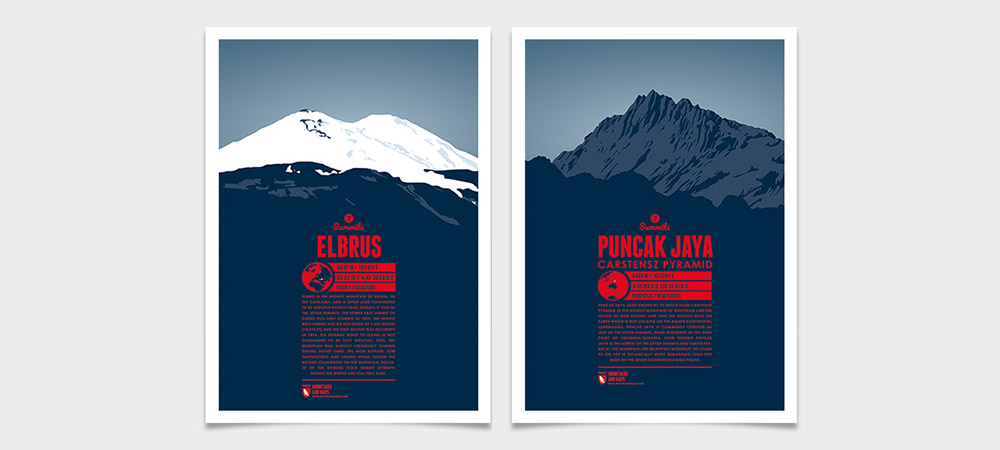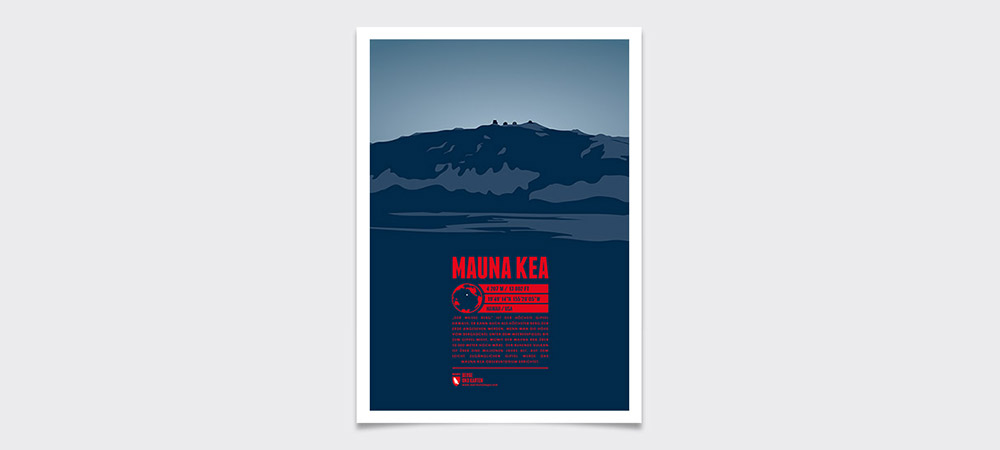– THE MOST IMPORTANT FACTS ABOUT THE HIGHEST PEAKS ON THE SEVEN CONTINENTS –
The highest mountains on the continents are also known as the Seven Summits. Climbing all of these seven peaks is one of the greatest achievement for mountaineers. But why are there exactly seven mountains, and which peaks are actually part of the Seven Summits? In the following article, we summarize the most important information about the highest mountains on the continents.
SEVEN CONTINENTS?
Which mountains are regarded as the Seven Summits depends on how you divide the continents and which landmasses you assign to them. This is particularly controversial for the demarcation of the European-Asian border and the question of which parts belong to Australia and Oceania. We have compiled everything you need to know about the continents, their number and their borders in another blog post.
The following list of the Seven Summits results from the continental division which we use at Marmota Maps:
- Mount Everest for Asia
- Aconcagua for South America
- Denali for North America
- Kilimanjaro (or Kibo) for Africa
- Elbrus for Europe
- Mount Vinson for Antarctica
- Puncak Jaya for Australia–Oceania

This list corresponds with the Messner list of the Seven Summits, which is widely recognized among mountaineers. Reinhold Messner varied the older Seven Summits list, created by American mountaineer Dick Bass. In contrast to Messner Bass listed Mount Kosciuszko on the Australian mainland as the highest elevation of the continent instead of Puncak Jaya on New Guinea. While most alpinists now largely seem to agree that Elbrus should be considered Europe’s highest peak, this is still a matter of controversy in geoscience. That is why Mont Blanc can still be found on many lists of Seven Summits as Europe’s highest mountain.

Mount Everest, Aconcagua and Mount Vinson, on the other hand, are completely undisputed as being the highest elevations of their respective continents.
EVEREST—THE ROOF OF THE WORLD IN ASIA
MOUNT EVEREST—NUMBERS & DATA
| Height: | 8,848 m (29,029 ft) |
| Topographic prominence: | 8,848 m (29,029 ft) |
| Topographic isolation: | 100 |
| Mountain range: | Himalaya (Mahalangur Himal) |
| Country / region: | Tibet, China & Khumbu, Nepal |
| First ascent: | 1953 |
As the highest point above sea level, the summit of Mount Everest logically has to be the highest point of its continent, as well. Regardless of whether you look at Asia as an independent continent, or add Europe or even Africa to the landmass—Mount Everest, the roof of the world, will always be the continental high point.
From a technical climbing viewpoint, the ascent to Everest’s summit is not considered to be too difficult. The main challenges and dangers are the high altitude and correspondingly the severely restricted oxygen supply, as well as extreme winds and cold. The sheer number of people at the summit during the main season, which often results in a slow ascent and descent, poses as another problem. This is due to an increase in the number of commercial expeditions. At least Tenzing Norgay and Edmund Hillary didn’t have this concern in the middle of the 20th century. Their first ascent to Everest on May 29, 1953 can be seen as one of the, if not the most important event in alpinism.
ACONCAGUA—THE HIGHEST MOUNTAIN OF AMERICA
ACONCAGUA—NUMBERS & DATA
| Height: | 6,961 m (22,837 ft) |
| Topographic prominence: | 6,961 m (22,837 ft) |
| Topographic isolation: | 100 |
| Mountain Range: | Andes (Cordillera Principal) |
| Country / region: | Mendoza, Argentina |
| First ascent: | 1897 |
The Cerro Aconcagua should not be missing on any list of the highest peaks on earth, either. It is the highest mountain on the North and South American continent, as well as the highest elevation in the southern and in the western hemisphere. And even if it is nowhere near the second highest mountain on earth—there are 177 taller peaks in Asia—with a topographical prominence of almost 7,000 meters, it is the world’s second most prominent peak after Mount Everest.
The ascent to Aconcagua is possible without technical climbing. The high altitude and the extreme weather conditions around the summit are potentially the greatest difficulties one faces during ascent. The first documented successfull ascent was made by Matthias Zurbriggen from Switzerland in 1897.
MOUNT VINSON—THE GIANT OF ANTARCTICA
MOUNT VINSON—NUMBERS & DATA
| Height: | 4,892 m (16,050 ft) |
| Topographic prominence: | 4,892 m (16,050 ft) |
| Topographic isolation: | 100 |
| Mountain range: | Ellsworth Mountains (Sentinal Range) |
| Country/ region: | Antarctica |
| First ascent: | 1966 |
Mount Vinson is the highest mountain in Antarctica. It wasn’t discovered until 1958, but was then quickly identified as the highest elevation on the southernmost continent. As with Everest and Aconcagua, this mountain, too, undisputedly belongs to the Seven Summits.
“Cold,” “extreme weather conditions,” “remote location” are attributes that apply to the conditions of some of the Seven Summits. In the case of Mount Vinson, this hardly describes how difficult it is to reach the highest mountain of the only uninhabited continent and how extreme the climate near the South Pole really is. In 1966, an American expedition led by Nicholas Clinch successfully climbed the southernmost of the Seven Summits.

After Mount Everest, Aconcagua and Mount Vinson, two other mountains can be found on nearly every Seven Summits list. North America, South America and Africa are generally seen as separate continents. Denali, formerly Mount McKinley, in Alaska forms the highest peak of North America followed by the Kibo on Kilimanjaro which is Africa’s highest elevation. Both are members of the Seven Summits family.
DENALI—THE HIGHEST SUMMIT IN THE NORTH
DENALI—NUMBERS & DATA
| Height: | 6,190 m (20,310 ft) |
| Topographic prominence: | 6,140 m (20,146 ft) |
| Topographic isolation: | 99 |
| Mountain range: | Alaska Range |
| Country / region: | Alaska, USA |
| First ascent: | 1913 |
Denali was formerly known as Mount McKinley. It is the only six-thousander in North America and, therefore, undoubtedly the highest peak on the continent. Its far up north location makes it the third most prominent mountain on earth following Mount Everest and Aconcagua, as well as the third highest and northernmost of the Seven Summits.
Even if Denali is significantly lower than Everest and Aconcagua, its height still requires good acclimatization of mountaineers. In addition, the climatic conditions prevailing in Alaska near the Pacific coast make ascent difficult. Low temperatures, high wind speeds and sudden weather changes are rather the rule than the exception on Denali. Climbing Denali is, therefore, considered to be a dry run for ascents to seven-thousander and eight-thousander peaks in Asia.
In 1913, an expedition, led by the American Harry Karstens, made the first documented ascent of the mountain. Out of a group of four, Walter Harper is said to have been the first to reach the summit.
KIBO IN MOUNT KILIMANJARO—THE HIGHEST SUMMIT IN AFRICA
KIBO—NUMBERS & DATA
| Height: | 5,895 m (19,341 ft) |
| Topographic prominence: | 5,885 m (19,308 ft) |
| Topographic isolation: | 99 |
| Mountain range: | Mount Kilimanjaro |
| Country / region: | Kilimanjaro, Tanzania |
| First ascent: | 1889 |
Kibo is the highest of the three volcanic cones in the Kilimanjaro massif. Its highest point is Uhuru Peak, which is also the high point of the entire African continent. Thus, the Kibo, or Kilimanjaro in common parlance, is indisputably one of the Seven Summits.
From a climbing point of view, the ascent to the summit offers comparatively little difficulty. Nevertheless, the dangers on the mountain should not be underestimated. Good acclimatization is also essential on Kilimanjaro. Bad weather or falling rocks can pose additional risks. In 1889, Hans Meyer and Ludwig Purtscheller made the first documented ascent of Kibo.

MONT BLANC OR ELBRUS—WHICH IS THE HIGHEST SUMMIT IN EUROPE?
Which mountain is the highest in Europe depends on where the continental border between Europe and Asia is being drawn. Due to the controversial course of the border between the Bosphorus and the Ural River, which we explain here, either the Mont Blanc in the Alps or the Elbrus in the Caucasus can be considered the highest mountain in Europe.
Many mountaineers seem to clearly lean towards Elbrus. The mountain can be found on Bass’s Seven Summits list as well as on Messner’s. The fact that the Elbrus is more than 800 meters taller than the Mont Blanc might also play a role.
The ascent to Elbrus via the normal route is considered to be comparatively easy. A good infrastructure of cable cars and mountain huts can be found on the mountain. Nevertheless, an above-average number of mountaineers are fatally injured here. In addition to altitude sickness, bad and sudden weather changes often pose as challenges to climbers of the highest mountain in the Caucasus. In 1874, the first ascent to the higher west summit was documented.
Due to its central location in the Alps, the Mont Blanc is a particularly much-climbed mountain. To mountaineers the question of Europe’s highest mountain has little relevance. This is probably due to the fact that the vast majority of people who have climbed the Seven Summits, including Elbrus, have already been on the summit of Mont Blanc, as well.
From a climbing viewpoint, the normal routes to Mont Blanc are not considered too difficult to ascend. But an altitude above 4,000 meters can be quite straining. In addition, the dangers of bad weather should never be underestimated when climbing in the Alps. On August 8, 1786 two Frenchmen, Jacques Balmat and Michel-Gabriel Paccard, were the first known people to reach the summit of the highest mountain in the Alps and Western Europe.
ELBRUS—NUMBERS & DATA
| Height: | 5,642 m (18,510 ft) |
| Topographic prominence: | 4,741 m (15,554 ft) |
| Topographic isolation: | 84 |
| Mountain range: | Caucasus |
| Country / region: | Russia |
| First ascent: | 1874 |
MONT BLANC—NUMBERS & DATA
| Height: | 4,809 m (15,777 ft) |
| Topographic prominence: | 4,696 m (15,407 ft) |
| Topographic isolation: | 98 |
| Mountain range: | Graian Alps |
| Country/ region: | Haute-Savoie, France / Aosta Valley, Italy |
| First ascent: | 1874 |
AUSTRALIA AND OCEANIA—MOUNT KOSCIUSZKO OR PUNCAK JAYA?
Equally controversial is the question which mountain is the highest peak in Australia and Oceania. Similar to Asia and Europe, there is no clear definition as to which landmasses are part of the seventh continent. Dick Bass, whose Seven Summits list rapidly gained popularity, considered Mount Kosciuszko, the highest mountain on the Australian mainland, as the highest peak on the continent. Even though it is disputed to what extent the Pacific Islands, from New Zealand to Micronesia, can still be regarded as part of the continent, geologically and geographically it makes sense to at least count the island of New Guinea as part of the Australian continent, since both are on the same continental plate. In that case, the highest peak in Australia or Australia–Oceania is Puncak Jaya, also known under its former Dutch name “Carstensz Pyramid”. Since the mountain is located in the western parts of Indonesia and, therefore, in a (mostly) Asian country, Mount Wilhelm, the highest elevation in Papua New Guinea, is also brought into play as the highest peak in Australia and Oceania. The underlying strict division of continents along political borders, however, entails many problems, if you only think of the example of Russia. Therefore this point of view is not very popular, neither among mountaineers nor scientists.
Mostly in Europe, Puncak Jaya is still commonly known as Carstensz pyramid, named after the Dutch sailor Jan Carstenszoon, who discovered the mountain in 1623. The fact that it is the highest mountain in Australia and Oceania seems largely indisputable. The island of New Guinea lies on the Australian continental plate and has only been separated from the Australian mainland since the end of the last ice age. And even if you count the Pacific Islands as part of the continent, there is no higher elevation than Puncak Jaya.
Also from an alpinist perspective, Puncak Jaya is the more interesting mountain. Even though Puncak Jaya is the lowest peak among all the Seven Summits, it presents one of the greatest climbing challenges when ascending the highest mountains of all continents. Frequent rain can make climbs and descents particularly slippery. Nevertheless, the weather conditions here are significantly better than at most of the other Seven Summits. The mountain consists of three summits. The highest of them was first conquered in 1962.
The summit of Mount Kosciuszko, on the other hand, can be reached with an easy hike. For Messner, this is explicitly another argument for considering Puncak Jaya as the highest continental peak. Until 1977, a road even ran almost all the way up to the summit of Mount Kosciuszko, which has, however, been closed since. The first documented ascent of the mountain took place in 1840.
PUNCAK JAYA—NUMBERS & DATA
| Height: | 4,884 m (16,024 ft) |
| Topographic prominence: | 4,884 m (16,024 ft) |
| Topographic isolation: | 100 |
| Mountain range: | New Guinea (Maoke Mountains) |
| Country / region: | Indonesia |
| First ascent: | 1962 |
MOUNT KOSCIUSZKO—NUMBERS & DATA
| Height: | 2,228 m (7,310 ft) |
| Topographic prominence: | 2,228 m ( 7,310 ft) |
| Topographic isolation: | 100 |
| Mountain range: | Snowy Mountains |
| Country/ region: | New South Wales, Australia |
| First ascent: | 1840 |
SEVEN SUMMITS OF THE CONTINENTAL PLATES
Another version of the lists of Seven Summits results from counting the highest elevations of the seven large continental plates. Six of the seven peaks would match with our list: Denali for North America, Aconcagua for South America, Kibo for Africa and Puncak Jaya for Australia. Instead of pointing out the highest mountain in Europe and in Asia, this list takes into account only Mount Everest as the highest elevation on the Eurasian plate. Finally, the seventh summit would be Mauna Kea on the Pacific Plate. It is the highest volcano on the island of Hawaii, and when measured from its underwater base it proves to be the tallest mountain on earth.
Similar to Mount Kosciuszko, the ascent to Mauna Kea offers no difficulty. The observatory on the summit has been accessible by road since the 1960s. The first documented ascent of the mountain took place in 1823.

MAUNA KEA—NUMBERS & DATA
| Height: | 4,207 m (13,803 ft) |
| Topographic prominence: | 4,207 m (13,803 ft) |
| Topographic isolation: | 100 |
| Country/ region: | Hawaii, USA |
| First ascent: | 1823 |
We have illustrated all of the Seven Summits as well as their alternatives, and we offer beautiful prints of them as wall decorations available in different sizes on paper, hard foam, Alu-Dibond and acrylic glass. If you buy our Seven Summits-bundle you get seven mountain prints for the price of six.

Our illustrated prints of the Seven Summits are also available in a bundle

